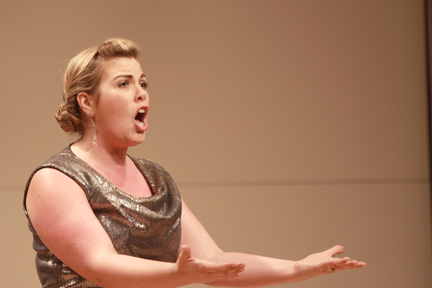The Gerald R. Daniel Recital Hall was illuminated with profound and angelic voices on Sept. 14 for “Dazzling Young Opera Stars.”
The event was organized by Jack Kates, a CSULB alumnus and critically acclaimed author. The event showcased current and alumni students from the CSULB Opera program.
Before any performances were brought to the stage, Kates slowly walked to the podium and initiated the event.
He humbly welcomed attendees and thanked parents, teachers, performers and other people who contributed to the opera production.
Kates joked about being an “impresario,” and playfully told attendees to respect him.
Regena Cole, Bob Cole’s wife, was also present at the event. Kates thanked and showed appreciation to Cole’s husband and praised his contribution to campus.
The Bob Cole Conservatory of Music was renamed in honor of Bob Cole, who left an endowment gift that provides scholarships and awards to students.
Kates, also invited “mystery guest” CSULB President Jane Close Conoley, to say a few words before the show began.
Coloney said she is always “blown away” by the accomplishments of creative students and appreciates that CSULB is a place where artists are celebrated.
The show was divided into two parts. Each segment of the event included nine songs with a brief intermission in between the two segments. After all of the 18 songs were performed, light refreshments concluded the event, and attendees were given a change to converse with performers.
The female performers included sopranos Heidi Harger, Amy Joy Stephens, Alyssa Wills and Australian coloratura soprano Beth Peregrine. The male performers at the event were baritones Anthony Moreno and Timothy Hall, tenor Joseph Lopez and bass baritone Nehemiah Chen.
Brian Farell, voice faculty at the Bob Cole Conservatory, was the pianist who complimented the wide range of voices heard throughout the production.
Before each performance, singers would outline what they were about to sing. They usually included the name of the song, where the track was originally from and a brief description and context of music that would be performed.
Each individual that performed wore elegant and formal attire. The women wore long dresses and the men suited up for the presentation.
Harger opened the event and asked the audience to stand while she sang “God Bless America.”
She then proceeded to sing “Porgi Amor” from “Le Nozze di Figaro.” The song laments the loss of a loved one and Hargers’ vocals displayed overwhelming emotions.
Other performers, like Stephens, sang music that was more jolly and uplifting. “Ah! Je Veux Vivre” from the scene in “Roméo et Juliette” where Juliette enters the party and finds love.
Stephens looked and searched into the distance and the performance allowed the audience to discover her embodiment of true happiness. Her voice was peppy, and Farell’s panio playing provided a merry waltz.
Male performers also did not disappoint. Emotional range didn’t just come from the voice of the singers, but their facial expressions as well.
“Ah, per sempre,” from “La Sonnambula,” and performed by Moreno, was an excellent example of such emotional performances. The song is about being in love with some one who returns the love, but is engaged to someone else. His performance embodied frustration.
The emotional performance complimented the background information that the singers provided. There was no need to understand the language because the emotions could be seen.
The event concluded with a performance by Stephens of “Ave Maria,” which she dedicated to Kates.
Kates came to the stage and said he was “embarrassed” that he had been brought to tears.
However, these were not somber tears. He said he felt like all performers are like his “children,” and dubbed the event “one of the happiest moments of my life.”





As the Director of the Opera Program at CSULB, I’m grateful that your staff took the time to review this production. Though it was an produced by an off-campus entity, it did feature only CSULB graduates and current students. We are all terribly proud of their work.
That being said, this review is awfully written by someone who clearly has not taken the time to learn what music review is supposed to look like. It misspells our University President’s name, it refers to opera arias as “songs,” and the scenes they come from as “tracks.” Furthermore, I wonder if the author actually listened to the thoughtful and intelligent introductions given by the performers. Ms. Harger clearly stated that her character, the Countess from Mozart’s ‘The Marriage of Figaro’, was singing about her husband’s proclivity towards cheating. She wasn’t singing about loss. How does an “Emotional performance compliment the background information that the singers provided”? No matter how you look at it, background information–whether offered via program notes or by a performer in an introduction–compliments the performance, not the other way around. Thank you for visiting the Conservatory, we have GREAT things going on every week. PLEASE, edit your articles clearly and spend some time reading classical music (or even pop music) reviews in good newspapers.